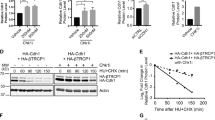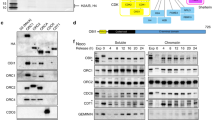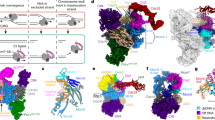Abstract
Ubiquitin-mediated proteolysis of the replication licensing factor Cdt1 (Cdc10-dependent transcript 1) in S phase is a key mechanism that limits DNA replication to a single round per cell cycle in metazoans1,2,3,4,5,6. In Xenopus egg extracts, Cdt1 is destroyed on chromatin during DNA replication1. Here, we report that replication-dependent proteolysis of Cdt1 requires its interaction with proliferating cell nuclear antigen (PCNA), a homotrimeric processivity factor for DNA polymerases7. Cdt1 binds to PCNA through a consensus PCNA-interaction motif that is conserved in Cdt1 of all metazoans, and removal of PCNA from egg extracts inhibits replication-dependent Cdt1 destruction. Mutation of the PCNA-interaction motif yields a stabilized Cdt1 protein that induces re-replication. DDB1, a component of the Cul4 E3 ubiquitin ligase that mediates human Cdt1 proteolysis in response to DNA damage8, is also required for replication-dependent Cdt1 destruction. Cdt1 and DDB1 interact in extracts, and DDB1 chromatin loading is dependent on the binding of Cdt1 to PCNA, which indicates that PCNA docking activates the pre-formed Cdt1–Cul4DDB1 ligase complex. Thus, PCNA functions as a platform for Cdt1 destruction, ensuring efficient and temporally restricted inactivation of a key cell-cycle regulator.
This is a preview of subscription content, access via your institution
Access options
Subscribe to this journal
Receive 12 print issues and online access
$209.00 per year
only $17.42 per issue
Buy this article
- Purchase on Springer Link
- Instant access to full article PDF
Prices may be subject to local taxes which are calculated during checkout





Similar content being viewed by others
References
Arias, E. E. & Walter, J. C. Replication-dependent destruction of Cdt1 limits DNA replication to a single round per cell cycle in Xenopus egg extracts. Genes Dev. 19, 114–126 (2005).
Li, A. & Blow, J. J. Cdt1 downregulation by proteolysis and geminin inhibition prevents DNA re-replication in Xenopus. EMBO J. 24, 395–404 (2005).
Maiorano, D., Krasinska, L., Lutzmann, M. & Mechali, M. Recombinant Cdt1 induces rereplication of G2 nuclei in Xenopus egg extracts. Curr. Biol. 15, 146–153 (2005).
Thomer, M., May, N. R., Aggarwal, B. D., Kwok, G. & Calvi, B. R. Drosophila double-parked is sufficient to induce re-replication during development and is regulated by cyclin E/CDK2. Development 131, 4807–4818 (2004).
Yoshida, K., Takisawa, H. & Kubota, Y. Intrinsic nuclear import activity of geminin is essential to prevent re-initiation of DNA replication in Xenopus eggs. Genes Cells 10, 63–73 (2005).
Zhong, W., Feng, H., Santiago, F. E. & Kipreos, E. T. CUL-4 ubiquitin ligase maintains genome stability by restraining DNA-replication licensing. Nature 423, 885–889 (2003).
Maga, G. & Hubscher, U. Proliferating cell nuclear antigen (PCNA): a dancer with many partners. J. Cell Sci. 116, 3051–3060 (2003).
Hu, J., McCall, C. M., Ohta, T. & Xiong, Y. Targeted ubiquitination of CDT1 by the DDB1-CUL4A-ROC1 ligase in response to DNA damage. Nature Cell Biol. 6, 1003–1009 (2004).
Dutta, A. & Bell, S. P. Initiation of DNA replication in eukaryotic cells. Annu. Rev. Cell. Dev. Biol. 13, 293–332 (1997).
Diffley, J. F. Once and only once upon a time: specifying and regulating origins of DNA replication in eukaryotic cells. Genes Dev. 10, 2819–2830 (1996).
Tada, S., Li, A., Maiorano, D., Mechali, M. & Blow, J. J. Repression of origin assembly in metaphase depends on inhibition of RLF-B/Cdt1 by geminin. Nature Cell Biol. 3, 107–113 (2001).
Wohlschlegel, J. A. et al. Inhibition of eukaryotic DNA replication by geminin binding to cdt1. Science 290, 2309–2312 (2000).
Nishitani, H., Taraviras, S., Lygerou, Z. & Nishimoto, T. The human licensing factor for DNA replication Cdt1 accumulates in G1 and is destabilized after initiation of S-phase. J. Biol. Chem. 276, 44905–44911 (2001).
Higa, L. A., Mihaylov, I. S., Banks, D. P., Zheng, J. & Zhang, H. Radiation-mediated proteolysis of CDT1 by CUL4-ROC1 and CSN complexes constitutes a new checkpoint. Nature Cell Biol. 5, 1008–1015 (2003).
Kondo, T. et al. Rapid degradation of Cdt1 upon UV-induced DNA damage is mediated by SCFSkp2 complex. J. Biol. Chem. 279, 27315–27319 (2004).
Arias, E. E. & Walter, J. C. Initiation of DNA replication in xenopus egg extracts. Front. Biosci. 9, 3029–3045 (2004).
Hubscher, U., Maga, G. & Spadari, S. Eukaryotic DNA polymerases. Annu. Rev. Biochem. 71, 133–163 (2002).
Nishitani, H., Lygerou, Z. & Nishimoto, T. Proteolysis of DNA replication licensing factor Cdt1 in S-phase is performed independently of geminin through its N-terminal region. J. Biol. Chem. 279, 30807–30816 (2004).
Li, X., Zhao, Q., Liao, R., Sun, P. & Wu, X. The SCF(Skp2) ubiquitin ligase complex interacts with the human replication licensing factor Cdt1 and regulates Cdt1 degradation. J. Biol. Chem. 278, 30854–30858 (2003).
Takeda, D. Y., Parvin, J. D. & Dutta, A. Degradation of Cdt1 during S phase is Skp2-independent and is required for efficient progression of mammalian cells through S phase. J. Biol. Chem. 280, 23416–23423 (2005).
Mattock, H. et al. Use of peptides from p21 (Waf1/Cip1) to investigate PCNA function in Xenopus egg extracts. Exp. Cell Res. 265, 242–251 (2001).
Shibahara, K. & Stillman, B. Replication-dependent marking of DNA by PCNA facilitates CAF-1-coupled inheritance of chromatin. Cell 96, 575–585 (1999).
Edwards, M. C. et al. MCM2-7 complexes bind chromatin in a distributed pattern surrounding ORC in Xenopus egg extracts. J. Biol. Chem. 277, 33049–33057 (2002).
Petroski, M. D. & Deshaies, R. J. Function and regulation of cullin-RING ubiquitin ligases. Natuer Rev. Mol. Cell Biol. 6, 9–20 (2005).
Claycomb, J. M., MacAlpine, D. M., Evans, J. G., Bell, S. P. & Orr-Weaver, T. L. Visualization of replication initiation and elongation in Drosophila. J. Cell Biol. 159, 225–236 (2002).
Gomes, X. V. & Burgers, P. M. Two modes of FEN1 binding to PCNA regulated by DNA. EMBO J. 19, 3811–3821 (2000).
May, N. R., Thomer, M., Murnen, K. F. & Calvi, B. R. The origin binding protein Double parked, and its inhibitor geminin, increase in response to replication stress. J. Cell Sci. 108, 4207–4717 (2005).
Chuang, L. C. & Yew, P. R. Proliferating cell nuclear antigen recruits cyclin-dependent kinase inhibitor Xic1 to DNA and couples its proteolysis to DNA polymerase switching. J. Biol. Chem. 280, 35299–35309 (2005).
Liu, E., Li, X., Yan, F., Zhao, Q. & Wu, X. Cyclin-dependent kinases phosphorylate human Cdt1 and induce its degradation. J. Biol. Chem. 279, 17283–17288 (2004).
Su'etsugu, M., Shimuta, T. R., Ishida, T., Kawakami, H. & Katayama, T. Protein associations in DnaA-ATP hydrolysis mediated by the Hda-replicase clamp complex. J. Biol. Chem. 280, 6528–6536 (2005).
Mimura, S., Masuda, T., Matsui, T. & Takisawa, H. Central role for cdc45 in establishing an initiation complex of DNA replication in Xenopus egg extracts. Genes Cells 5, 439–452 (2000).
Walter, J., Sun, L. & Newport, J. Regulated chromosomal DNA replication in the absence of a nucleus. Mol. Cell 1, 519–529 (1998).
Acknowledgements
We thank T. Takahashi for numerous helpful suggestions, and W. Harper and D. Finley for insightful comments on the manuscript. We also thank C. Cvetic and T. Prokhorova for preparation of the Orc2 and Cdt1 antisera, and J. Pascal and T. Ellenberger for providing recombinant PCNA. E.E.A is an Howard Hughes Medical Institute pre-doctoral fellow. This work was supported by an American Cancer Society grant (106201) to J.C.W.
Author information
Authors and Affiliations
Corresponding author
Ethics declarations
Competing interests
The authors declare no competing financial interests.
Supplementary information
Supplementary Information
Supplementary figures S1, S2, S3 and S4 (PDF 1296 kb)
Rights and permissions
About this article
Cite this article
Arias, E., Walter, J. PCNA functions as a molecular platform to trigger Cdt1 destruction and prevent re-replication. Nat Cell Biol 8, 84–90 (2006). https://doi.org/10.1038/ncb1346
Received:
Accepted:
Published:
Issue Date:
DOI: https://doi.org/10.1038/ncb1346
This article is cited by
-
The cohesin modifier ESCO2 is stable during DNA replication
Chromosome Research (2023)
-
SPOP mutation induces replication over-firing by impairing Geminin ubiquitination and triggers replication catastrophe upon ATR inhibition
Nature Communications (2021)
-
Regulation of cell cycle drivers by Cullin-RING ubiquitin ligases
Experimental & Molecular Medicine (2020)
-
The ORC ubiquitin ligase OBI1 promotes DNA replication origin firing
Nature Communications (2019)
-
The replication initiation determinant protein (RepID) modulates replication by recruiting CUL4 to chromatin
Nature Communications (2018)



